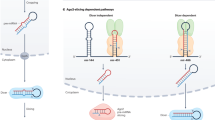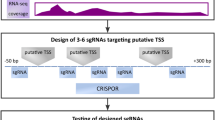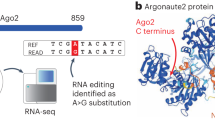Abstract
Most metazoan microRNAs (miRNAs) target many genes for repression, but the nematode lsy-6 miRNA is much less proficient. Here we show that the low proficiency of lsy-6 can be recapitulated in HeLa cells and that miR-23, a mammalian miRNA, also has low proficiency in these cells. Reporter results and array data indicate two properties of these miRNAs that impart low proficiency: their weak predicted seed-pairing stability (SPS) and their high target-site abundance (TA). These two properties also explain differential propensities of small interfering RNAs (siRNAs) to repress unintended targets. Using these insights, we expand the TargetScan tool for quantitatively predicting miRNA regulation (and siRNA off-targeting) to model differential miRNA (and siRNA) proficiencies, thereby improving prediction performance. We propose that siRNAs designed to have both weaker SPS and higher TA will have fewer off-targets without compromised on-target activity.
This is a preview of subscription content, access via your institution
Access options
Subscribe to this journal
Receive 12 print issues and online access
$189.00 per year
only $15.75 per issue
Buy this article
- Purchase on Springer Link
- Instant access to full article PDF
Prices may be subject to local taxes which are calculated during checkout




Similar content being viewed by others
References
Ambros, V. The functions of animal microRNAs. Nature 431, 350–355 (2004).
Bartel, D.P. MicroRNAs: genomics, biogenesis, mechanism, and function. Cell 116, 281–297 (2004).
Bartel, D.P. MicroRNAs: target recognition and regulatory functions. Cell 136, 215–233 (2009).
Lewis, B.P., Burge, C.B. & Bartel, D.P. Conserved seed pairing, often flanked by adenosines, indicates that thousands of human genes are microRNA targets. Cell 120, 15–20 (2005).
Brennecke, J., Stark, A., Russell, R.B. & Cohen, S.M. Principles of microRNA-target recognition. PLoS Biol. 3, e85 (2005).
Krek, A. et al. Combinatorial microRNA target predictions. Nat. Genet. 37, 495–500 (2005).
Grimson, A. et al. MicroRNA targeting specificity in mammals: determinants beyond seed pairing. Mol. Cell 27, 91–105 (2007).
Friedman, R.C., Farh, K.K., Burge, C.B. & Bartel, D.P. Most mammalian mRNAs are conserved targets of microRNAs. Genome Res. 19, 92–105 (2009).
Shin, C. et al. Expanding the microRNA targeting code: functional sites with centered pairing. Mol. Cell 38, 789–802 (2010).
Lim, L.P. et al. Microarray analysis shows that some microRNAs downregulate large numbers of target mRNAs. Nature 433, 769–773 (2005).
Krützfeldt, J. et al. Silencing of microRNAs in vivo with 'antagomirs'. Nature 438, 685–689 (2005).
Farh, K.K. et al. The widespread impact of mammalian microRNAs on mRNA repression and evolution. Science 310, 1817–1821 (2005).
Giraldez, A.J. et al. Zebrafish MiR-430 promotes deadenylation and clearance of maternal mRNAs. Science 312, 75–79 (2006).
Nielsen, C.B. et al. Determinants of targeting by endogenous and exogenous microRNAs and siRNAs. RNA 13, 1894–1910 (2007).
Robins, H., Li, Y. & Padgett, R.W. Incorporating structure to predict microRNA targets. Proc. Natl. Acad. Sci. USA 102, 4006–4009 (2005).
Zhao, Y., Samal, E. & Srivastava, D. Serum response factor regulates a muscle-specific microRNA that targets Hand2 during cardiogenesis. Nature 436, 214–220 (2005).
Kertesz, M., Iovino, N., Unnerstall, U., Gaul, U. & Segal, E. The role of site accessibility in microRNA target recognition. Nat. Genet. 39, 1278–1284 (2007).
Long, D. et al. Potent effect of target structure on microRNA function. Nat. Struct. Mol. Biol. 14, 287–294 (2007).
Hammell, M. et al. mirWIP: microRNA target prediction based on microRNA-containing ribonucleoprotein-enriched transcripts. Nat. Methods 5, 813–819 (2008).
Saetrom, P. et al. Distance constraints between microRNA target sites dictate efficacy and cooperativity. Nucleic Acids Res. 35, 2333–2342 (2007).
Kedde, M. et al. RNA-binding protein Dnd1 inhibits microRNA access to target mRNA. Cell 131, 1273–1286 (2007).
Ruby, J.G. et al. Evolution, biogenesis, expression, and target predictions of a substantially expanded set of Drosophila microRNAs. Genome Res. 17, 1850–1864 (2007).
Didiano, D. & Hobert, O. Perfect seed pairing is not a generally reliable predictor for miRNA-target interactions. Nat. Struct. Mol. Biol. 13, 849–851 (2006).
Ui-Tei, K., Naito, Y., Nishi, K., Juni, A. & Saigo, K. Thermodynamic stability and Watson-Crick base pairing in the seed duplex are major determinants of the efficiency of the siRNA-based off-target effect. Nucleic Acids Res. 36, 7100–7109 (2008).
Franco-Zorrilla, J.M. et al. Target mimicry provides a new mechanism for regulation of microRNA activity. Nat. Genet. 39, 1033–1037 (2007).
Ebert, M.S., Neilson, J.R. & Sharp, P.A. MicroRNA sponges: competitive inhibitors of small RNAs in mammalian cells. Nat. Methods 4, 721–726 (2007).
Anderson, E.M. et al. Experimental validation of the importance of seed complement frequency to siRNA specificity. RNA 14, 853–861 (2008).
Arvey, A., Larsson, E., Sander, C., Leslie, C.S. & Marks, D.S. Target mRNA abundance dilutes microRNA and siRNA activity. Mol. Syst. Biol. 6, 363 (2010).
Rodriguez, A. et al. Requirement of bic/microRNA-155 for normal immune function. Science 316, 608–611 (2007).
Baek, D. et al. The impact of microRNAs on protein output. Nature 455, 64–71 (2008).
Bird, A. DNA methylation patterns and epigenetic memory. Genes Dev. 16, 6–21 (2002).
Xia, T. et al. Thermodynamic parameters for an expanded nearest-neighbor model for formation of RNA duplexes with Watson-Crick base pairs. Biochemistry 37, 14719–14735 (1998).
Guo, H., Ingolia, N.T., Weissman, J.S. & Bartel, D.P. Mammalian microRNAs predominantly act to decrease target mRNA levels. Nature 466, 835–840 (2010).
Selbach, M. et al. Widespread changes in protein synthesis induced by microRNAs. Nature 455, 58–63 (2008).
Lall, S. et al. A genome-wide map of conserved microRNA targets in C. elegans. Curr. Biol. 16, 460–471 (2006).
Jan, C.H., Friedman, R.C., Ruby, J.G. & Bartel, D.P. Formation, regulation and evolution of Caenorhabditis elegans 3′ UTRs. Nature 469, 97–101 (2011).
Didiano, D. & Hobert, O. Molecular architecture of a miRNA-regulated 3′ UTR. RNA 14, 1297–1317 (2008).
Huesken, D. et al. Design of a genome-wide siRNA library using an artificial neural network. Nat. Biotechnol. 23, 995–1001 (2005).
Schwarz, D.S. et al. Asymmetry in the assembly of the RNAi enzyme complex. Cell 115, 199–208 (2003).
Khvorova, A., Reynolds, A. & Jayasena, S.D. Functional siRNAs and miRNAs exhibit strand bias. Cell 115, 209–216 (2003).
Bartel, D.P. & Chen, C.Z. Micromanagers of gene expression: the potentially widespread influence of metazoan microRNAs. Nat. Rev. Genet. 5, 396–400 (2004).
Stark, A., Brennecke, J., Bushati, N., Russell, R.B. & Cohen, S.M. Animal MicroRNAs confer robustness to gene expression and have a significant impact on 3′UTR evolution. Cell 123, 1133–1146 (2005).
Seitz, H. Redefining microRNA targets. Curr. Biol. 19, 870–873 (2009).
Ameres, S.L., Martinez, J. & Schroeder, R. Molecular basis for target RNA recognition and cleavage by human RISC. Cell 130, 101–112 (2007).
Parker, J.S., Parizotto, E.A., Wang, M., Roe, S.M. & Barford, D. Enhancement of the seed-target recognition step in RNA silencing by a PIWI/MID domain protein. Mol. Cell 33, 204–214 (2009).
Lewis, B.P., Shih, I.H., Jones-Rhoades, M.W., Bartel, D.P. & Burge, C.B. Prediction of mammalian microRNA targets. Cell 115, 787–798 (2003).
Pruitt, K.D., Katz, K.S., Sicotte, H. & Maglott, D.R. Introducing RefSeq and LocusLink: curated human genome resources at the NCBI. Trends Genet. 16, 44–47 (2000).
Imanishi, T. et al. Integrative annotation of 21,037 human genes validated by full-length cDNA clones. PLoS Biol. 2, e162 (2004).
Lander, E.S. et al. Initial sequencing and analysis of the human genome. Nature 409, |860–921 (2001).
Kent, W.J. BLAT–the BLAST-like alignment tool. Genome Res. 12, 656–664 (2002).
Okazaki, Y. et al. Analysis of the mouse transcriptome based on functional annotation of 60,770 full-length cDNAs. Nature 420, 563–573 (2002).
Waterston, R.H. et al. Initial sequencing and comparative analysis of the mouse genome. Nature 420, 520–562 (2002).
Ruby, J.G. et al. Large-scale sequencing reveals 21U-RNAs and additional microRNAs and endogenous siRNAs in C. elegans. Cell 127, 1193–1207 (2006).
Griffiths-Jones, S., Saini, H.K., van Dongen, S. & Enright, A.J. miRBase: tools for microRNA genomics. Nucleic Acids Res. 36, D154–D158 (2008).
Rhead, B. et al. The UCSC Genome Browser database: update 2010. Nucleic Acids Res. 38, D613–D619 (2010).
Acknowledgements
We thank D. Didiano and O. Hobert (Columbia University) for lsy-6 target constructs and V. Auyeung, R. Friedman, C. Jan and H. Guo for helpful discussions and for sharing data sets before publication. This work was supported by US National Institutes of Health grant GM067031 (D.P.B.) and a Research Settlement Fund for the new faculty of SNU (D.B.). D.P.B. is an investigator of the Howard Hughes Medical Institute.
Author information
Authors and Affiliations
Contributions
D.M.G. carried out most reporter assays and associated experiments and analyses. D.B. carried out all the computational analyses except for reporter analyses. G.W.B. implemented revisions to the TargetScan site. C.S. and A.G. carried out assays and analyses involving miR-23. D.M.G., D.B. and D.P.B. wrote the paper.
Corresponding authors
Ethics declarations
Competing interests
The authors declare no competing financial interests.
Supplementary information
Supplementary Text and Figures
Supplementary Figures 1–5 and Supplementary Tables 1–5. (PDF 2239 kb)
Supplementary Data 1
175 microarrays analyzed in this study. (XLSX 24 kb)
Supplementary Data 2
Human and C. elegans miRNA families, conserved in vertebrates and nematodes, respectively. (XLSX 22 kb)
Supplementary Data 3
Reference mRNAs. (ZIP 17965 kb)
Supplementary Data 4
mRNA fold-change values. (XLSX 17534 kb)
Supplementary Data 5
Predicted SPS and TA values for all heptamers in C. elegans, human and HeLa, mouse, and D. melanogaster. (XLSX 3972 kb)
Rights and permissions
About this article
Cite this article
Garcia, D., Baek, D., Shin, C. et al. Weak seed-pairing stability and high target-site abundance decrease the proficiency of lsy-6 and other microRNAs. Nat Struct Mol Biol 18, 1139–1146 (2011). https://doi.org/10.1038/nsmb.2115
Received:
Accepted:
Published:
Issue Date:
DOI: https://doi.org/10.1038/nsmb.2115
This article is cited by
-
Cirscan: a shiny application to identify differentially active sponge mechanisms and visualize circRNA–miRNA–mRNA networks
BMC Bioinformatics (2024)
-
Uncovering hidden cancer self-dependencies through analysis of shRNA-level dependency scores
Scientific Reports (2024)
-
Aflatoxin B1 affects porcine alveolar macrophage growth through the calcium signaling pathway mediated by the ceRNA regulatory network
Molecular Biology Reports (2023)
-
CXCL14 and miR-4484 serves as potential salivary biomarkers for early detection of peri-implantitis
Odontology (2023)
-
The Network Zoo: a multilingual package for the inference and analysis of gene regulatory networks
Genome Biology (2023)



